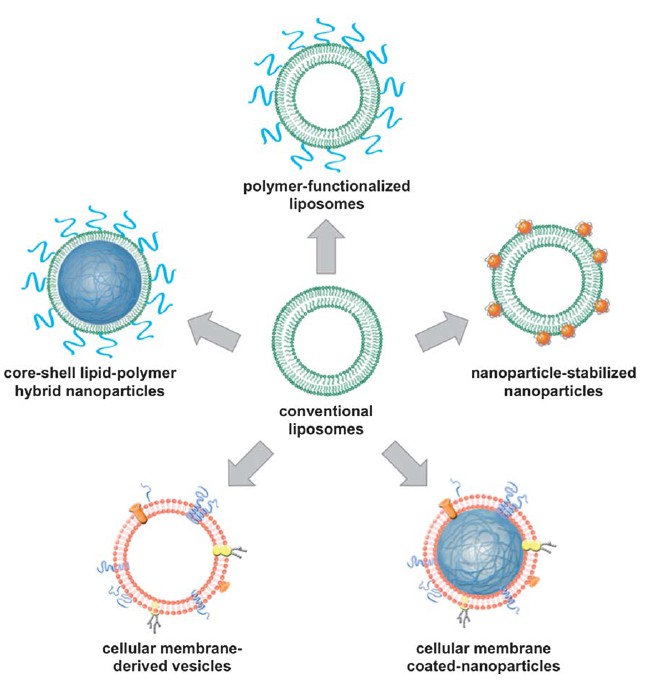The combination of liposomes and nanoparticles is called a liposome complex. Studies have shown that the combination of nanoparticles and liposomes can effectively improve the physicochemical properties of liposomes, so as to better realize the targeted delivery and controlled release of drugs. CD Bioparticles provides a variety of polymer materials combined with liposomes, including alginate, chitosan, collagen, cyclodextrin, gelatin, hyaluronic acid, lactoferrin, transferrin, polyacrylic acid, poly Acrylamide and polyethylene glycol etc. We are committed to providing quality services to meet your various needs in research.
Liposomes are widely adopted as nanocarriers for hydrophobic or hydrophilic molecules. However, traditional liposomes are rapidly degraded and eliminated in vivo, so there are challenges in the application of specific routes such as oral and systemic routes. One of the ways to overcome this difficulty is by forming complexes with nanoparticles, i.e. liposome complex. The addition of nanoparticles can improve the stability of liposomes in different pH values, chemical environments, enzymes and immune systems. Studies have shown that natural and synthetic polymers can be used to adjust the structure and physicochemical properties of liposomes to achieve their applications in targeted delivery, controlled release and stability of drugs and vaccines. These properties are affected by the polymer type, crosslinkers, interactions and bonds during the complexation process.
 Figure 1. Schematic diagram of Liposome-Nanoparticle.(Gao W, et al. 2013)
Figure 1. Schematic diagram of Liposome-Nanoparticle.(Gao W, et al. 2013)
Coupling polymers to liposomes is an approach to improve the physicochemical properties, stability, and pharmacokinetic properties of liposomes. Different types of polymers interact with liposomes with different morphological complexity. These interactions are also influenced by the state (cyclic or acyclic) of the initial phospholipid. Typically, the polymers incorporated into the original liposome material create fusion interactions on or within the bilayer chains of the liposome. However, if the polymers are introduced after the formation of the liposome bilayer membrane, interactions will occur at the surface. The types of interactions that may occur between polymers and liposomes include physical adsorption or chemical reactions, such as electrostatic interactions, hydrogen bonds, disulfide bonds, covalent bonds, etc. Weak bonds, such as hydrogen bonds, dipole bonds, and disulfide bonds, release liposomes slowly over hours to days. However, if the bonds formed are covalent or ionic, more energy or biocatalysts (enzymes) are required to break these bonds.
Surface modification of liposomes can effectively prevent bonding or adsorption with certain proteins during circulation. In addition, surface modification can also enable targeted drug delivery using ligands, receptors or polymers that can be stimulated by specific pH values, enzyme activities or specific bonds on the cell substrate to induce rupture of liposomes, thereby initiating the endocytic process and drug release. CD Bioparticles has a leading polymer biocoupling technology platform, which can provide efficient liposome biocoupling services for various targets and research needs, including magnetic response, thermal response, pH response, enzyme response, and tumor-targeted delivery and controlled release.
The incorporation of polymers into the liposome bilayer enhances the stability of the liposome membrane, making it stronger and more stable during chemical, enzymatic, and immune reactions. The polymers embedded in the lamella chains are hydrophobic, so they bind well to the fatty chains of lipophospholipids. In addition, this interaction can also be stimulated by temperature, enzyme or pH to achieve controlled drug release inside the liposome. At CD Bioparticles, we can tailor the integration of lipid-polymer coupling according to the different types and structures of polymers, cross-linkers and lipids.
Such internal interactions typically occur when already formed hydrophilic polymers act as proliposome matrix systems. These interactions include easy-to-implement and reliable interaction behaviors. Therefore, this system can be used in drug delivery systems that are readily chemically degradable or photodegradable. In addition, this internal interaction also affects the strength of bonds between lamella chains in liposomes. In addition to selecting the most suitable polymers, crosslinkers and lipids based on client research needs, CD Bioparticles can also perform standard evaluations to observe interaction patterns and their impact on the physicochemical properties of liposome complexes.
Various combinations of interactions can be achieved by combining different types of polymers and liposomes, which can be achieved by adjusting the combination of polymers or adding cross-linking agents. This mixture can be composed of hydrophilic and hydrophobic polymers to simplify drug loading and to impart triglycerol properties to liposomes. Therefore, an appropriate compounding approach can even enable the delivery of multiple drugs with different release patterns for synergistic effects. CD Bioparticles' advanced platform technology improves the physicochemical properties of liposomes through the lipid-polymer complex process, providing support for research projects on targeted delivery and controlled release of drugs.
Drug delivery field: Liposome constitutes a drug delivery system, which is composed of phospholipids and is widely used to enhance the solubility and permeability of hydrophilic and hydrophobic drugs. By combining with nanoparticles, the stability of liposome is improved, thereby enhancing its drug delivery efficiency.
Vaccine delivery: Liposome-polymer complexes have been identified as novel adjuvants and vaccine delivery platforms because of their unique potential for immunogenic stimulation compared to non-functional nanocarriers and traditional carrier proteins.
If you don't see what you need, or don't know what you need, please Contact Us and our team will work with you to find the right solution for your analysis.
Quotations and Ordering

References
1. Download the template.
2. Enter product information on the template (maximum number of products: 200).
3. Load the file using selector below.
1. Download the template.
2. Enter product information on the template (maximum number of products: 200).
3. Load the file using selector below.